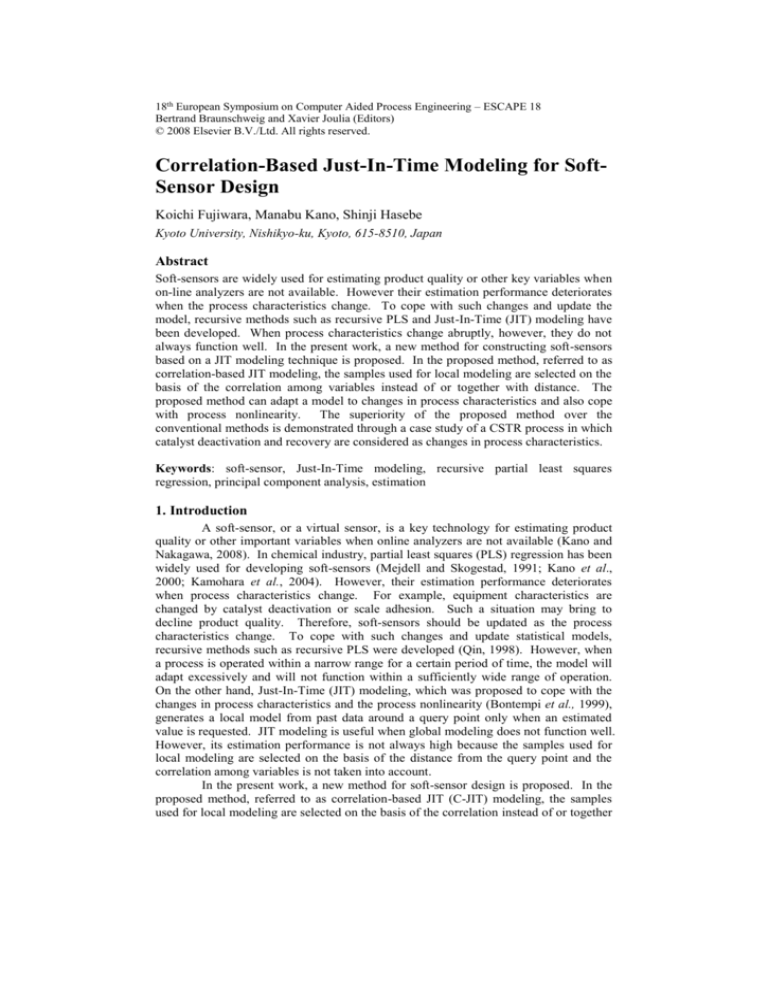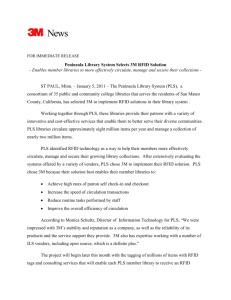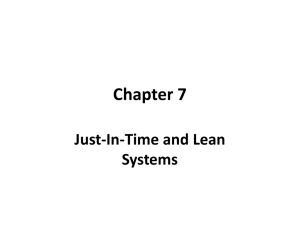
18th European Symposium on Computer Aided Process Engineering – ESCAPE 18
Bertrand Braunschweig and Xavier Joulia (Editors)
© 2008 Elsevier B.V./Ltd. All rights reserved.
Correlation-Based Just-In-Time Modeling for SoftSensor Design
Koichi Fujiwara, Manabu Kano, Shinji Hasebe
Kyoto University, Nishikyo-ku, Kyoto, 615-8510, Japan
Abstract
Soft-sensors are widely used for estimating product quality or other key variables when
on-line analyzers are not available. However their estimation performance deteriorates
when the process characteristics change. To cope with such changes and update the
model, recursive methods such as recursive PLS and Just-In-Time (JIT) modeling have
been developed. When process characteristics change abruptly, however, they do not
always function well. In the present work, a new method for constructing soft-sensors
based on a JIT modeling technique is proposed. In the proposed method, referred to as
correlation-based JIT modeling, the samples used for local modeling are selected on the
basis of the correlation among variables instead of or together with distance. The
proposed method can adapt a model to changes in process characteristics and also cope
with process nonlinearity. The superiority of the proposed method over the
conventional methods is demonstrated through a case study of a CSTR process in which
catalyst deactivation and recovery are considered as changes in process characteristics.
Keywords: soft-sensor, Just-In-Time modeling, recursive partial least squares
regression, principal component analysis, estimation
1. Introduction
A soft-sensor, or a virtual sensor, is a key technology for estimating product
quality or other important variables when online analyzers are not available (Kano and
Nakagawa, 2008). In chemical industry, partial least squares (PLS) regression has been
widely used for developing soft-sensors (Mejdell and Skogestad, 1991; Kano et al.,
2000; Kamohara et al., 2004). However, their estimation performance deteriorates
when process characteristics change. For example, equipment characteristics are
changed by catalyst deactivation or scale adhesion. Such a situation may bring to
decline product quality. Therefore, soft-sensors should be updated as the process
characteristics change. To cope with such changes and update statistical models,
recursive methods such as recursive PLS were developed (Qin, 1998). However, when
a process is operated within a narrow range for a certain period of time, the model will
adapt excessively and will not function within a sufficiently wide range of operation.
On the other hand, Just-In-Time (JIT) modeling, which was proposed to cope with the
changes in process characteristics and the process nonlinearity (Bontempi et al., 1999),
generates a local model from past data around a query point only when an estimated
value is requested. JIT modeling is useful when global modeling does not function well.
However, its estimation performance is not always high because the samples used for
local modeling are selected on the basis of the distance from the query point and the
correlation among variables is not taken into account.
In the present work, a new method for soft-sensor design is proposed. In the
proposed method, referred to as correlation-based JIT (C-JIT) modeling, the samples
used for local modeling are selected on the basis of the correlation instead of or together
2
K. Fujiwara et al.
with the distance. The C-JIT modeling can cope with abrupt changes of process
characteristics that conventional method cannot. The usefulness of the proposed
method is demonstrated through a case study of a CSTR process in which catalyst
deactivation and recovery are investigated as the changes in process characteristics.
2. Conventional methods
In this section, conventional soft-sensor design methods are briefly explained.
2.1. Dynamic PLS
PLS has been widely used for building a soft-sensor because it can cope with a
colinearity problem. Here X N M and Y N L are matrices whose ith rows are
the ith measurements of inputs xi and outputs yi, respectively. The columns of these
matrices are mean-centered and scaled appropriately. In PLS, X and Y are decomposed
as follows:
(1)
X TPT E , Y TQT F
where T N R is the latent variable matrix, P M R and Q L R are the loading
matrices of X and Y , respectively. R denotes the number of latent variables. E and F
are the error matrices. The estimation performance of soft-sensors can be improved by
taking into account process dynamics. For this purpose, the past information is used as
inputs in addition to the present information. This method is referred to as Dynamic
PLS (Ricker, 1993; Kano et al., 2000).
2.2. Recursive PLS
The estimation performance of a statistical model will deteriorate when process
characteristics change.
Therefore, soft-sensors should be updated as process
characteristics change. However, redesign of them is very laborious and it is difficult to
determine when they should be updated. To cope with these problems, recursive PLS
was proposed (Qin, 1998). Whenever both new input and output variables, x new and
y new , are measured, the recursive PLS updates the model by using
P T
Q T
X new T Ynew T , 0 1
x new
y new
where is the forgetting factor.
(2)
2.3. Just-In-Time modeling
In general, a global linear model cannot function well when a process has
strong nonlinearity in its operation range, and it is difficult to construct a nonlinear
model that is applicable to a wide operation range since a huge amount of samples are
required. Therefore, methods that divide a process operation region into small multiple
regions and build a local model in each small region have been proposed. An example
is a piecewise affine (PWA) model (Ferrari-Trecate et al., 2003). However, in the PWA
model, the optimal division of the operation region is not always clear and the
interpolation between the local models is complicated. Another method for developing
local models is JIT modeling, which has the following features:
When new input and output data are available, they are stored into a database.
Only when estimation is required, a local model is constructed from samples located
in a neighbor region around the query point and output variables are estimated.
The constructed local model is discarded after its use for estimation.
Correlation-Based Just-In-Time Modeling for Soft-Sensor Design
3
In JIT modeling, samples for local modeling should be selected appropriately and online computational load becomes large.
3. Correlation based Just-In-Time modeling
Conventional JIT modeling uses a distance to define a neighbor region around
the query point regardless of the correlation among variables. In the present work, a
new JIT modeling method that takes account of the correlation is proposed. In the
proposed C-JIT modeling method, the data set that has the correlation best fit to the
query sample is selected for local modeling.
3.1. Evaluation of correlation similarity
Although several indices of similarity between data sets have been proposed
(Kano et al., 2001; Kano et al, 2002), the Q statistic is used in C-JIT modeling. The Q
statistic is derived from principal component analysis (PCA), which is a tool for data
compression and information extraction (Jackson and Mudholkar, 1979).
P
(x
Q
p
xˆ p ) 2
(3)
p 1
where x̂ p is the prediction of the pth input variable by PCA. The Q statistic is a
distance between the sample and the subspace spanned by principal components. That
is, the Q statistic is a measure of dissimilarity between the sample and the modeling
data from the viewpoint of the correlation among variables. In addition, to avoid
extrapolation, Hotelling's T 2 statistic can be used.
R
t r2
T2
(4)
2
r 1
where
2
tr
tr
denotes the variance of the rth score
t r . The T 2 statistic expresses
normalized distance from the origin in the subspace spanned by principal components.
To improve the model reliability, Q and T 2 can be integrated into a single index for the
data set selection as proposed by Raich and Cinar (1994) for a different purpose:
(5)
J T 2 (1 )Q, 0 1
3.2. Correlation-based Just-In-Time modeling
In the proposed C-JIT modeling, samples stored in the database are divided
into several data sets. Although the method of generating data sets is arbitrary, each
data set is generated so that it consists of successive samples included in a certain period
of time in this work, because the correlation among variables in such a data set is
expected to be very similar. To build a local model, the index J in Eq. (5) is calculated
for each data set, and the data set that minimizes J is selected as the modeling data set.
Figure 1 shows the difference of sample selection for local modeling between
JIT modeling and C-JIT modeling. The samples consist of two groups that have
different correlation. In conventional JIT modeling, samples are selected regardless of
the correlation, since a neighbor region around the query point is defined by distance.
On the other hand, C-JIT modeling can select samples whose correlation is similar to
that of the query point by using the Q statistic.
Assume that S samples are stored in the database and z i [ xiT , yiT ]T . To cope
with process dynamics, measurements at different sampling points can be included in z i .
The procedure of C-JIT modeling is as follows:
4
K. Fujiwara et al.
1. Newly measured input and output measurements z S 1 are stored in the database.
2. The index J is calculated from z S 1 and a data set z {S } that was used for building the
previous local model f {S } . J I J .
3. If J I J I , then f {S 1} f {S} and Z {S 1} Z {S} . f {S 1} is used for estimation until
the next input and output measurements z S 2 are available. When z S 2 is available,
return to step 1. If J I J I , go to the next step. Here J I is the threshold.
4. k 1 .
5. The kth data set Z k [ z k , , z k W 1 ]T ( M L)W is extracted from the database,
where W is the window size.
6. The index J of the kth data set, J k , is calculated from Z k and z S 1 .
7. k k d . If k S W 1 , then return to step 5. If k S W 1 , then go to the
next step. Here d is the window moving width.
8. The data set Z k that minimizes J k is selected, and it is defined as Z {S 1} .
9. A new local model f {S 1} whose input is X {S 1} [ x K , x K W 1 ]T and output is
Y {S 1} [ y K , , y K W 1 ]T is built.
10. The updated model f {S 1} is used for estimation until the next input and output
measurements z S 2 are available. When z S 2 is available, return to step 1.
Principal component regression (PCR) is used in the proposed C-JIT modeling
because scores are calculated in step 6. In addition, steps 2 and 3 control the model
update frequency.
Fig. 1: Sample selection for local modeling in JIT modeling (left) and C-JIT modeling (right).
4. Case Study
In this section, the estimation performance of the proposed C-JIT modeling is
compared with that of recursive PLS and conventional JIT modeling through their
applications to product composition estimation for a CSTR process.
4.1. Problem Settings
A schematic diagram of the CSTR process is shown in Fig. 2 (Johannesmeyer
and Seborg, 1999). In this process, an irreversible reaction A B takes place. The set
point of reactor temperature is changed between 2K every ten days. Measurements
of five variables, reactor temperature T, reactor level h, reactor exit flow rate Q, coolant
flow rate QC, and reactor feed flow rate QF, are used for the analysis and their sampling
interval is one minute. In addition, reactant concentration CA is measured in a
Correlation-Based Just-In-Time Modeling for Soft-Sensor Design
5
laboratory once a day. A soft-sensor that can estimate CA accurately in real time needs
to be developed. In this case study, to consider catalyst deactivation as the changes in
process characteristics, the frequency factor k0 is assumed to decrease with time. In
addition, the catalyst is recovered every half year (180 days). Figure 3 shows the
deterioration and recovery of the frequency factor. The operation data for the past 540
days were stored in the database. While newly measured data are stored, the soft-sensor
is updated in the next 180 days.
4.2. Estimation by Recursive PLS and Just-In-Time modeling
Soft-sensors are constructed by using recursive PLS with the forgetting factor
0.97 and JIT modeling. In recursive PLS, the model is updated every 24 hours
when CA is measured. To take into account process dynamics, the inputs consist of the
samples at present and one minute before. The number of latent variables is four, which
is determined by trial and error. On the other hand, in JIT modeling, linear local models
are built by using Euclid distance as the measure of selecting samples used for local
modeling. Matlab Lazy Learning Toolbox was used (http://iridia.ulb.ac.be/~lazy).
The estimation results are shown in Table 1. In this table, r denotes the
correlation coefficient between measurements and estimates, and RMSE is the root
mean square error. The results show that neither recursive PLS nor JIT modeling
functions well. In general, recursive PLS is suitable only for slow changes in process
characteristics. On the other hand, the reason for the poor performance of JIT modeling
seems that JIT modeling does not take account of correlation among variables when a
local model is built.
Fig2: Schematic diagram of CSTR.
Fig. 3: Change of a frequency factor.
Table 1: Estimation performance of recursive PLS, JIT modeling, and C-JIT modeling
r
RMSE
recursive PLS
0.88
2.07
JIT modeling
0.82
2.43
C-JIT modeling
0.99
0.54
Fig. 4: Estimation result of CA by C-JIT modeling with 0.01 (Window Size: 10 day).
6
K. Fujiwara et al.
4.3. Estimation by Correlation-based Just-In-Time modeling
The criterion for selecting a data set is to minimize the index J in Eq. (5) with
0.01 . The local model is updated every 24 hours when CA is measured, W=10, and
d=1, which are determined by trial and error. The estimation results are shown in Fig. 4
and Table 1. The left figure shows the estimation result for 180 days. The right figure
shows the enlarged result for two months before and after the catalyst recovery. In this
figure, PCs is the number of principal components. The results show that the estimation
performance of C-JIT modeling is significantly higher than that of the conventional
methods. With the proposed C-JIT modeling, RMSE is improved by about 78% and
74% in comparison with recursive PLS and JIT modeling, respectively.
5. Conclusion
In the present work, to develop a soft-sensor that can cope with the changes in
process characteristics, a new correlation-based JIT modeling method is proposed. The
superiority of the proposed C-JIT modeling over the conventional methods is
demonstrated through a case study of a CSTR process in which catalyst deactivation
and recovery are investigated. In recursive PLS and conventional JIT modeling, it is
difficult to adapt models when the process characteristics change abruptly. On the other
hand, the C-JIT modeling can cope with the abrupt changes in process characteristics.
References
G. Bontempi, M. Birattari and H. Bersini, 1999, Lazy Learing for Local Modelling and Control
Design, Int. J. Cont., Vol. 72, No. 7/8, 643
G. Ferrari-Trecate, M. Muselli, D. Liberati, and M. Morari, 2003, A Clustring Technique for the
Identification of Piecewise Affine System, Automatica, Vol. 39, Issue 2, 205
J. E. Jackson, and G. S. Mudholkar, 1979, Control Procedures for Residuals Associated with
Principal Component Analysis, Technometrics, Vol. 21, Issue 3, 341
M. Johannesmeyer and D. E. Sebog, 1995, Abnormal Situation Anaylsis Using Pattern
Recognition Techniques and Histrical Data, AIChE Annual meeting, Dallas, Oct.31-Nov. 5
H. Kamohara, A. Takinami, M. Takeda, M. Kano, S. Hasebe and I. Hashimoto, 2004, Product
Quality Estimation and Operating Condition Monitoring for Industrial Ethylene Fractionator,
J. Chem. Eng. Japan, Vol.. 37, No.3, 422
M. Kano, S. Hasebe, I. Hashimoto and H. Ohno, 2002, Statistical Process Monitoring Based on
Dissimilarity of Process Data, AIChE J., Vol. 48, No.6, 1231
M. Kano and Y. Nakagawa ,2008, Data-Based Process Monitoring, Process Control, and Quality
Improvement: Recent Developments and Applications in Steel Industry, Comput. Chem.
Engng., Vol. 32, 12
M. Kano, H. Ohno, S. Hasebe, and I. Hashimoto, 2001, A New Multivariate Statistical Process
Monitoring Method Using Principal Component Analysis, Comput. Chem. Engng., Vol. 25,
No.7-8, 1103
M. Kasper and W. H. Ray, 1993, Partial Least Squares Modeling as Successive Singular Value
Decomposition, Comput. Chem. Engng., Vol. 17, Issue 10, 985
T. Mejdell and S. Skogestad, 1991, Estimation of Distillation Compositions from Multiple
Temperature Measurements Using Partial-Least-Squares Regression, Ind. Eng. Chem. Res.,
Vol. 30, Issue 12, 2543
S. J. Qin, 1998, Recursive PLS Algorithms for Adaptive Data Modeling, Comput. Chem. Engng.,
Vol. 22, No. 4/5, 503
A. Raich and A. Cinar, 1994, Statistical Process Monitoring and Disturbance Diagnosis in
Multivariable Continuous Processes, AIChE J., Vol. 42, Issue 1,995
N. L. Ricker, 1988, Use of Biased Least-Squares Estimators for Parameters in Discrete-Time
Pulse Response Models, Ind. Eng. Chem. Res., Vol. 27, Issue 2, 343










